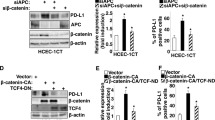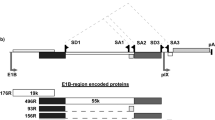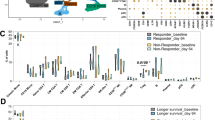Abstract
Mutation of the adenomatous polyposis coli and β-catenin genes in colon cancer leads to constitutive activation of transcription from promoters containing binding sites for Tcf/LEF transcription factors. We have constructed adenoviruses with Tcf binding sites in the early promoters, in order to target viral replication to colon tumours. Tcf regulation of the E1A promoter confers a 100-fold selectivity for cells with activated wnt signalling in viral burst and cytopathic effect assays. p300 is a coactivator for β-catenin, and E1A inhibits Tcf-dependent transcription through sequestration of p300, but mutation of the p300 binding site in E1A leads to a 10-fold reduction in cytopathic effect of all of the Tcf-regulated viruses. When Tcf sites are inserted in the E1A, E1B, E2 and E4 promoters the viruses show up to 100 000-fold selectivity for cells with activated wnt signalling.
This is a preview of subscription content, access via your institution
Access options
Subscribe to this journal
Receive 6 print issues and online access
$259.00 per year
only $43.17 per issue
Buy this article
- Purchase on SpringerLink
- Instant access to full article PDF
Prices may be subject to local taxes which are calculated during checkout








Similar content being viewed by others
References
Rodriguez R. et al. Prostate attenuated replication competent adenovirus (ARCA) CN706: a selective cytotoxic for prostate-specific antigen-positive prostate cancer cells Cancer Res 1997 57: 2559 2559
Yu D.C., Sakamoto G.T., Henderson D.R. . Identification of the transcriptional regulatory sequences of human kallikrein 2 and their use in the construction of calydon virus 764, an attenuated replication competent adenovirus for prostate cancer therapy Cancer Res 1999 59: 1498 1498
Hallenbeck P.L. et al. A novel tumor-specific replication-restricted adenoviral vector for gene therapy of hepatocellular carcinoma Hum Gene Ther 1999 10: 1721 1721
Hernandez-Alcoceba R., Pihalja M., Wicha M.S., Clarke M.F. . A novel, conditionally replicative adenovirus for the treatment of breast cancer that allows controlled replication of E1a-deleted adenoviral vectors Hum Gene Ther 2000 11: 2009 2009
Heise C. et al. An adenovirus E1A mutant that demonstrates potent and selective systemic anti-tumoral efficacy Nature Med 2000 6: 1134 1134
Khuri F. et al. A controlled trial of intratumoral ONYX-015, a selectively-replicating adenovirus, in combination with cisplatin and 5-fluorouracil in patients with recurrent head and neck cancer Nature Med 2000 6: 879 879
Heise C. et al. ONYX-015, an E1B gene-attenuated adenovirus, causes tumor-specific cytolysis and antitumoral efficacy that can be augmented by standard chemotherapeutic agents Nature Med 1997 3: 639 639
Bischoff J.R. et al. An adenovirus mutant that replicates selectively in p53-deficient human tumor cells Science 1996 274: 373 373
Chen Y., Yu D.C., Charlton D., Henderson D.R. . Pre-existent adenovirus antibody inhibits systemic toxicity and antitumor activity of CN706 in the nude mouse LNCaP xenograft model: implications and proposals for human therapy Hum Gene Ther 2000 11: 1553 1553
Teichler Z.D. . US gene therapy in crisis Trends Genet 2000 16: 272 272
Brunori M., Malerba M., Kashiwazaki H., Iggo R. . Replicating adenoviruses that target tumors with constitutive activation of the wnt signaling pathway J Virol 2001 75: 2857 2857
Polakis P. . Wnt signaling and cancer Genes Dev 2000 14: 1837 1837
Korinek V. et al. Constitutive transcriptional activation by a beta-catenin-Tcf complex in APC-/- colon carcinoma Science 1997 275: 1784 1784
He T.C. et al. Identification of c-MYC as a target of the APC pathway Science 1998 281: 1509 1509
Tetsu O., McCormick F. . Beta-catenin regulates expression of cyclin D1 in colon carcinoma cells Nature 1999 398: 422 422
Roose J. et al. Synergy between tumor suppressor APC and the beta-catenin-Tcf4 target Tcf1 Science 1999 285: 1923 1923
Crawford H.C. et al. The metalloproteinase matrilysin is a target of beta-catenin transactivation in intestinal tumors Oncogene 1999 18: 2883 2883
Lipinski K.S. et al. High-level, beta-catenin/TCF-dependent transgene expression in secondary colorectal cancer tissue Molec Ther 2001 4: 365 365
Chen R.H., McCormick F. . Selective targeting to the hyperactive beta-catenin/T-cell factor pathway in colon cancer cells Cancer Res 2001 61: 4445 4445
Hearing P., Shenk T. . The adenovirus type 5 E1A enhancer contains two functionally distinct domains: one is specific for E1A and the other modulates all early units in cis Cell 1986 45: 229 229
Challberg M.D., Kelly T.J. . Animal virus DNA replication Annu Rev Biochem 1989 58: 671 671
Amalfitano A., Chamberlain J.S. . Isolation and characterization of packaging cell lines that coexpress the adenovirus E1, DNA polymerase, and preterminal proteins: implications for gene therapy Gene Therapy 1997 4: 258 258
Cottu P.H. et al. Inverse correlation between RER+ status and p53 mutation in colorectal cancer cell lines Oncogene 1996 13: 2727 2727
Hecht A. . The p300/CBP acetyltransferases function as transcriptional coactivators of beta-catenin in vertebrates EMBO J 2000 19: 1839 1839
Takemaru K.I., Moon R.T. . The transcriptional coactivator CBP interacts with beta-catenin to activate gene expression J Cell Biol 2000 149: 249 249
Reid J.L. et al. E1A directly binds and regulates the P/CAF acetyltransferase EMBO J 1998 17: 4469 4469
Brannon M. et al. XCtBP is a XTcf-3 co-repressor with roles throughout Xenopus development Development 1999 126: 3159 3159
Bauer A. et al. Pontin52 and Reptin52 function as antagonistic regulators of beta-catenin signalling activity EMBO J 2000 19: 6121 6121
Fajas L. et al. pRB binds to and modulates the transrepressing activity of the E1A-regulated transcription factor p120E4F Proc Natl Acad Sci USA 2000 97: 7738 7738
Roose J., Clevers H. . TCF transcription factors: molecular switches in carcinogenesis Biochim Biophys Acta 1999 1424: M23 M23
Sun Y. et al. Regulation of beta-catenin transformation by the p300 transcriptional coactivator Proc Natl Acad Sci USA 2000 97: 12613 12613
Lipinski K.S., Esche H., Brockmann D. . Amino acids 1-29 of the adenovirus serotypes 12 and 2 E1A proteins interact with rap30 (TF(II)F) and TBP in vitro Virus Res 1998 54: 99 99
Lewis B.A. et al. Adenovirus E1A proteins interact with the cellular YY1 transcription factor J Virol 1995 69: 1628 1628
Lee J.S. et al. Relief of YY1 transcriptional repression by adenovirus E1A is mediated by E1A-associated protein p300 Genes Dev 1995 9: 1188 1188
Kraus V.B. et al. Interaction of the Dr1 inhibitory factor with the TATA binding protein is disrupted by adenovirus E1A Proc Natl Acad Sci USA 1994 91: 6279 6279
Bonneaud N. et al. A family of low and high copy replicative integrative and single-stranded S. cerevisiae/E. coli shuttle vectors Yeast 1991 7: 609 609
Leza M.A., Hearing P. . Cellular transcription factor binds to adenovirus early region promoters and to a cyclic AMP response element J Virol 1988 62: 3003 3003
Gagnebin J. et al. A photosensitising adenovirus for photodynamic therapy Gene Therapy 1999 6: 1742 1742
Alevizopoulos K., Catarin B., Vlach J., Amati B. . A novel function of adenovirus E1A is required to overcome growth arrest by the CDK2 inhibitor p27(Kip1) EMBO J 1998 17: 5987 5987
Alevizopoulos K., Sanchez B., Amati B. . Conserved region 2 of adenovirus E1A has a function distinct from pRb binding required to prevent cell cycle arrest by p16INK4a or p27Kip1 Oncogene 2000 19: 2067 2067
van de Wetering M. et al. Armadillo coactivates transcription driven by the product of the Drosophila segment polarity gene dTCF Cell 1997 88: 789 789
Blanco J.C. et al. The histone acetylase PCAF is a nuclear receptor coactivator Genes Dev 1998 12: 1638 1638
Wood M.A., McMahon S.B., Cole M.D. . An ATPase/helicase complex is an essential cofactor for oncogenic transformation by c-Myc Mol Cell 2000 5: 321 321
Cajot J.F., Sordat I., Silvestre T., Sordat B. . Differential display cloning identifies motility-related protein (MRP1/CD9) as highly expressed in primary compared to metastatic human colon carcinoma cells Cancer Res 1997 57: 2593 2593
Chen X., Ko L.J., Jayaraman L., Prives C. . p53 levels, functional domains, and DNA damage determine the extent of the apoptotic response of tumor cells Genes Dev 1996 10: 2438 2438
Sarnow P., Sullivan C.A., Levine A.J. . A monoclonal antibody detecting the adenovirus type 5-E1b-58Kd tumor antigen: characterization of the E1b-58Kd tumor antigen in adenovirus-infected and -transformed cells Virology 1982 120: 510 510
Reich N.C., Sarnow P., Duprey E., Levine A.J. . Monoclonal antibodies which recognize native and denatured forms of the adenovirus DNA-binding protein Virology 1983 128: 480 480
Marton M.J., Baim S.B., Ornelles D.A., Shenk T. . The adenovirus E4 17-kilodalton protein complexes with the cellular transcription factor E2F, altering its DNA-binding properties and stimulating E1A-independent accumulation of E2 mRNA J Virol 1990 64: 2345 2345
Evan G.I., Lewis G.K., Ramsay G., Bishop J.M. . Isolation of monoclonal antibodies specific for human c-myc proto-oncogene product Mol Cell Biol 1985 5: 3610 3610
Acknowledgements
We thank E Lurati and A Ducraux for expert technical assistance. We thank M Malerba for providing the cMM1 cell line. We thank K Alevizopoulos, J Chamberlain, H Clevers, MD Cole, T Dobner, AJ Levine, C Prives, B Sordat and D Trono for supplying reagents. We thank M Peter and P Beard for critical reading of the manuscript and M Brunori for helpful discussions. We thank the Swiss National Science Foundation, Swiss Cancer League, Roche Research Foundation and ISREC for financial support.
Author information
Authors and Affiliations
Rights and permissions
About this article
Cite this article
Fuerer, C., Iggo, R. Adenoviruses with Tcf binding sites in multiple early promoters show enhanced selectivity for tumour cells with constitutive activation of the wnt signalling pathway. Gene Ther 9, 270–281 (2002). https://doi.org/10.1038/sj.gt.3301651
Received:
Accepted:
Published:
Issue date:
DOI: https://doi.org/10.1038/sj.gt.3301651
Keywords
This article is cited by
-
A modified E2F-1 promoter improves the efficacy to toxicity ratio of oncolytic adenoviruses
Gene Therapy (2009)
-
Evaluation of Twenty-One Human Adenovirus Types and One Infectivity-Enhanced Adenovirus for the Treatment of Malignant Melanoma
Journal of Investigative Dermatology (2008)
-
Cellular genetic tools to control oncolytic adenoviruses for virotherapy of cancer
Journal of Molecular Medicine (2008)
-
Comparison of herpes simplex virus- and conditionally replicative adenovirus-based vectors for glioblastoma treatment
Cancer Gene Therapy (2007)
-
Fusion of the BCL9 HD2 domain to E1A increases the cytopathic effect of an oncolytic adenovirus that targets colon cancer cells
BMC Cancer (2006)



